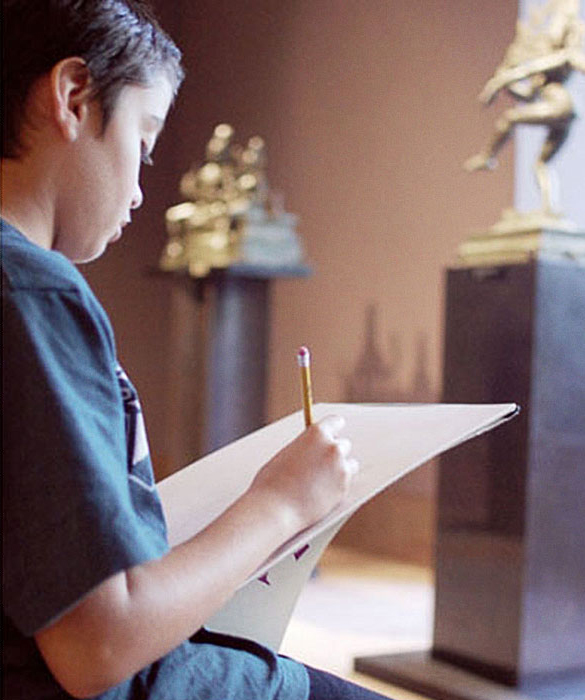Traditional School to Homeschool

After my son felt lost in the system when he transitioned from elementary to middle school, I made the decision to homeschool him temporarily. I wanted him to learn how to be self-reliant and focused. Strongly feeling that his grades and self-esteem were intertwined, I created a curriculum that would ensure he got a substantial amount of one-on-one time away from the pressures of a classroom setting. He's since returned and feels much more confident in his academic abilities.
Curriculum That Works For You

At first, it may be hard to decide which curriculum to choose. There are so many different approaches—Eclectic, Unschooling, Waldorf, Traditional—to name a few. Choose one or combine several, but research and decide what’s best for you and your child. Does your child need a very structured routine? Is he or she a kinesthetic learner? Do they relish in the arts? There’s much to consider when picking a curriculum. You can always change your mind along the way—and you probably will!
Plan Ahead

Set short-term and long-term goals and keep a schedule. Part of your child’s learning experience should involve a routine. However, you must remember that your child’s homeschool day is not like a regular school day. Expect the unexpected at all times and go with the flow. Set a guideline (or a lesson plan) but leave room for some spontaneity. There will definitely be days you won’t be able to do it all, and that’s OK!
Stock Up on Healthy Snacks

Now that your child is home, you have a lot more control over their daily meals and snacks. Make sure to have plenty of fruits and veggies for them to have handy while they work. The pantry will become part of the day, so it’s important to eliminate bad options. Replace juice boxes with water bottles, and chips with healthy snacks using fruits and vegetables.
Physical Activity

Remaining active isn’t easy for many busy families. Believe me, we know! If you can’t get around to the gym or don’t have the time to commit to an organized sport, go for a walk, jog or dance to music. If the weather is bad, there are plenty of at-home workout video games you can try. Get the heart pumping every day as much as possible.
Socialization

Socialization in homeschooled life is a challenge and finding homeschool communities is not as easy as one would think! Even if you find them, you may not have much in common in your academic approaches, religious beliefs or lifestyle. Remain flexible and committed to finding a community that’s a good fit. Check out local organizations such as your area’s YMCA, art classes, library workshops and programs, a local sports team or by going the old-fashioned route and calling up friends they previously attended school with. If you homeschool under the umbrella of a charter school, they can help you find groups in your area as well.
Be Creative

Combine subjects! You can mix art with math (Mondrian, anyone?). English with history. Science with cooking. Working on an art project? Play some music! For Black History Month, we created a simple collage of Miles Davis while listening to jazz. Learning about ancient India? Try yoga! My son didn’t really understand the concept of meditation and yoga until I actually signed him up for a class. He loved it. Learning about Mexico? Get yourself an enchilada recipe and spend the afternoon cooking. Take learning out of the textbooks and live it!
You Don't Have To Be An Expert

Sometimes parents feel they can’t possibly teach a subject they aren’t experts in. Science and math are not my forte. Instead of me teaching my son math, he attended a tutoring program. For science, we would sit and read chapters aloud together. As he read, he learned new things and as I read, I remembered things I was taught in school. It was a great process for us both. You don’t need to have a masters in Physics or a Ph.D in mathematics to be able to teach your child those subjects.
Don't Be Afraid To Ask For Help

My comfort zone is history and art so I combined a lot of writing, projects and field trips. My son’s grandmothers wanted to pitch in somehow but live out-of-state, so they helped with literature and language arts via Skype! The point is to get your child to love learning. Accept the help if offered and seek alternatives for subjects that may not be your thing.
Have Fun

Remember, your child is no longer in a school setting. Take the textbooks to the park, a historical site or simply cuddle on the couch while reading about scientific data graphs or the Qin Dynasty. Remove stress and pressure, and help encourage a love of learning. If you live near a museum or library, check out their programs and spend the day exploring. Learning can happen anywhere. Make it a part of your child’s life (and yours) and they’ll barely notice they’re doing work.




